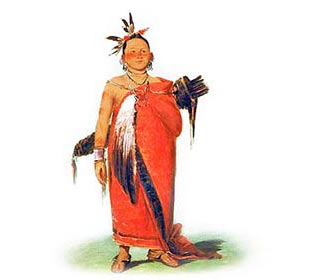The names of the Minnesota tribes included the Arapaho, Cheyenne, Chippewa, Dakota Sioux, Fox and Sauk. Woodland tribes were Iowa, Omaha, Otoe, Ottawa, Ponca (see above picture), Winnebago and Huron (aka the Wyandot). Fast Facts about the History of Minnesota Indians
The climate, land, history, environment and natural resources that were available to the indigenous Indian tribes in Minnesota resulted in the adoption of the Woodlands culture and some adopted the Great Plains Indians culture. - Name of State: Minnesota
- Meaning of State name: A Dakota word meaning “Whitish or Sky-tinted water.”
- Geography, Environment and Characteristics of the State of Minnesota: hill and lake region, ridges and lakes, plains and river valleys
- Culture adopted by Minnesota Indians: Woodlands culture and some adopted the Great Plains culture.
- Languages: Muskogean, Athabaskan and Algonquian
- Way of Life (Lifestyle): Hunter-gatherers, farmers, fishers, trappers
- Types of housing, homes or shelters: Tepees, Chickees, Wigwams (aka Birchbark houses) and Longhouses
History Timeline of the Minnesota Indians - 10,000 B.C.: Paleo-Indian Era (Stone Age culture) the earliest human inhabitants of America who lived in caves and were Nomadic hunters of large game including the Great Mammoth and giant bison
- 7000 BC: Archaic Period in which people built basic shelters and made stone weapons and stone tools
- 1000 AD: Woodland Period including the Hopewell cultures established along rivers in the Northeastern and Midwestern United States which included trade exchange systems and burial systems
- 1000: Mississippian Culture established. This was the last of the mound-building cultures of North America in Midwestern, Eastern, and Southeastern United States
- 1659: Between 1659-1660 French fur traders Pierre-Esprit Radisson (1636 - 1710) and Médard Chouart, Sieur des Groseilliers (1618 - 1710) explore western end of Lake Superior
- 1679: Daniel Greysolon, Sieur du Luth (1636–1710) claims the upper Mississippi region for France
- 1770: Grand Portage is established as the fur trading crossroads in northern Minnesota (1770 -1804)
- 1775: 1775 - 1783 - The American Revolution.
- 1776: July 4, 1776 - United States Declaration of Independence
- 1803: The United States bought the Louisiana Territory from France for 15 million dollars for the land
- 1812: 1812 - 1815: The War of 1812 between U.S. and Great Britain, ended in a stalemate but confirmed America's Independence
- 1830: Indian Removal Act
- 1832: Department of Indian Affairs established
- 1858: Minnesota was admitted to the Union
- 1861: 1861 - 1865: The American Civil War.
- 1862: Sioux Indian war in Minnesota and Dakota, aka the Dakota War of 1862. The Sioux killed upwards of 1,000 settlers in Minnesota then fled to Dakota territory pursued by 5000 US Cavalry soldiers
- 1862: U.S. Congress passes Homestead Act opening the Great Plains to settlers
- 1865: The surrender of Robert E. Lee on April 9 1865 signalled the end of the Confederacy
- 1887: Dawes General Allotment Act passed by Congress leads to the break up of the large Indian Reservations and the sale of Indian lands to white settlers
- 1898: Battle of Sugar Point US Infantry and Chippewa Indians in Minnesota
- 1969: All Indians declared citizens of U.S
- 1979: American Indian Religious Freedom Act was passed
History of Minnesota Indians - Destruction and Decline
The history of the European invasion brought epidemic diseases such as tuberculosis, cholera, influenza, measles and smallpox. The Native Indians of Minnesota had not developed immunities against these diseases resulting in huge losses in population. Exploitation including the leverage of taxes, enforced labor and enslavement were part of their history, taking their toll on the Minnesota Indians. |
